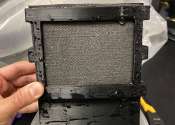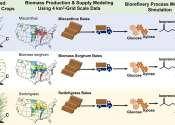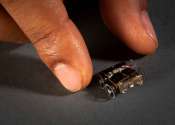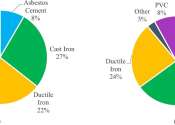New fuel cell harvests energy from microbes in soil to power sensors, communications
A Northwestern University-led team of researchers has developed a new fuel cell that harvests energy from microbes living in dirt.
Jan 15, 2024
0
45
Energy & Green Tech

A Northwestern University-led team of researchers has developed a new fuel cell that harvests energy from microbes living in dirt.
Jan 15, 2024
0
45
Energy & Green Tech

Every year, airplanes crisscrossing U.S. skies burn 23 billion gallons of fuel, leaving contrails and 8% of the nation's transportation-related greenhouse gas (GHG) emissions in their wake. A recent study published in Proceedings ...
Dec 15, 2023
0
22
Robotics

Small mobile robots carrying sensors could perform tasks like catching gas leaks or tracking warehouse inventory. But moving robots demands a lot of energy, and batteries, the typical power source, limit lifetime and raise ...
Sep 27, 2023
0
182
Engineering

Manchester scientists have created a new material, dubbed StarCrete, which is made from extra-terrestrial dust, potato starch, and a pinch of salt and could be used to build homes on Mars.
Mar 16, 2023
1
107
Robotics

Researchers at Istituto Italiano di Tecnologia (IIT-Italian Institute of Technology) in Genoa has realized a new soft robot inspired by the biology of earthworms, which is able to crawl thanks to soft actuators that elongate ...
Mar 1, 2023
0
226
Electronics & Semiconductors

Computer scientists at the University of California San Diego are showing how soil microbes can be harnessed to fuel low-power sensors. This opens new possibilities for microbial fuel cells (MFCs), which can power soil hydration ...
Mar 30, 2022
0
258
Energy & Green Tech

Engineers at the University of Bath have shown that it's possible to capture and use energy created by the natural reactions occurring in microorganisms within soil.
Oct 28, 2020
0
117
Engineering

Canadians are no strangers to water main breaks. Aging equipment, increased demand, seasonal weather changes, and many other factors have added stress to the infrastructure of utilities across Canada.
Apr 16, 2024
0
0
Energy & Green Tech

Unplanned power outages due to environmental conditions (wind, lightning, tree growth, etc.) leave those without power on their own, sometimes for long periods of time. Utility companies lack the ability to predict when forced ...
Mar 4, 2024
0
1
Energy & Green Tech

A new approach to waste management could help villages in rural India cut indoor air pollution, improve soil health, and generate clean power, researchers say.
Feb 23, 2024
0
49
Soil is a natural body consisting of layers (soil horizons) of mineral constituents of variable thicknesses, which differ from the parent materials in their morphological, physical, chemical, and mineralogical characteristics. It is composed of particles of broken rock that have been altered by chemical and environmental processes that include weathering and erosion. Soil differs from its parent rock due to interactions between the lithosphere, hydrosphere, atmosphere, and the biosphere. It is a mixture of mineral and organic constituents that are in solid, gaseous and aqueous states. Soil particles pack loosely, forming a soil structure filled with pore spaces. These pores contain sol solution (liquid) and air (gas). Accordingly, soils are often treated as a three state system. Most soils have a density between 1 and 2 g/cm³. Soil is also known as earth: it is the substance from which our planet takes its name. Little of the soil composition of planet Earth is older than Tertiary and most no older than Pleistocene. In engineering, soil is referred to as regolith, or loose rock material.
This text uses material from Wikipedia, licensed under CC BY-SA